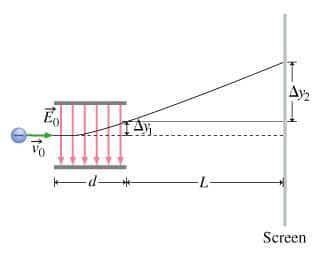
Physics, 24.03.2020 21:23 genyjoannerubiera
In the late 19th century, great interest was directed toward the study of electrical discharges in gases and the nature of so-called cathode rays. One remarkable series of experiments with cathode rays, conducted by J. J. Thomson around 1897, led to the discovery of the electron. With the idea that cathode rays were charged particles, Thomson used a cathode-ray tube to measure the ratio of charge to mass, q/m, of these particles, repeating the measurements with different cathode materials and different residual gases in the tube.
Part A
What is the most significant conclusion that Thomson was able to draw from his measurements?
a. He found a different value of q/m for different cathode materials.
b. He found the same value of q/m for different cathode materials.
c. From measurements of q/m he was able to calculate the charge of an electron.
d. From measurements of q/m he was able to calculate the mass of an electron.
Part B
What is the distance Δy between the two points that you observe? Assume that the plates have length d, and use e and m for the charge and the mass of the electrons, respectively.
Express your answer in terms of e, m, d, v0, L, and E0.
Part C
In your experiment, you measure a total deflection of 4.12 cm when an electric field of 1.10×103V/m is established between the plates (with no magnetic field present). When you add the magnetic field, to what value do you have to adjust its magnitude B0 to observe no deflection? Assume that the plates are 6.00 cm long and that the distance between them and the screen is 12.0 cm. Express your answer numerically in tesla.

Answers: 2


Another question on Physics

Physics, 22.06.2019 16:30
Acalorimeter uses the principle that thermal energy flows from hotter material to colder material until both reach the same
Answers: 1


Physics, 23.06.2019 00:00
Examine the drawing of a molecule. each ring represents an atom of nitrogen (n). what’s the chemical formula of this substance?
Answers: 2

Physics, 23.06.2019 03:30
Explain how a step-down transformer makes electricity safe for use in homes
Answers: 2
You know the right answer?
In the late 19th century, great interest was directed toward the study of electrical discharges in g...
Questions

History, 17.09.2019 21:10

Mathematics, 17.09.2019 21:10

Mathematics, 17.09.2019 21:10




Chemistry, 17.09.2019 21:10

















 :
:


 , while the vertical velocity is
, while the vertical velocity is


 (1)
(1)
 (strength of the electric field)
(strength of the electric field) (electron charge)
(electron charge) is the mass of the electron
is the mass of the electron

 is the magnitude of the magnetic field.
is the magnitude of the magnetic field.



